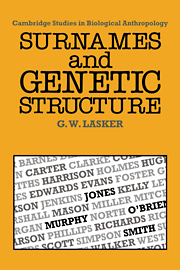Book contents
- Frontmatter
- Contents
- Preface
- 1 Introduction
- 2 History of surname studies in human biology
- 3 Sources of data
- 4 Methods
- 5 Isolates and inbreeding
- 6 Island versus distance models: the Far East and Oceania
- 7 The Americas and continental Europe
- 8 Scotland and Ireland
- 9 Regions of England
- 10 English cities and the general population of England and Wales
- 11 Specific surnames in Great Britain
- 12 Human population structure
- Literature cited
- Appendix maps and diagrams, of the distribution of 100 surnames in England and Wales
- Glossary
- Index
3 - Sources of data
Published online by Cambridge University Press: 05 November 2011
- Frontmatter
- Contents
- Preface
- 1 Introduction
- 2 History of surname studies in human biology
- 3 Sources of data
- 4 Methods
- 5 Isolates and inbreeding
- 6 Island versus distance models: the Far East and Oceania
- 7 The Americas and continental Europe
- 8 Scotland and Ireland
- 9 Regions of England
- 10 English cities and the general population of England and Wales
- 11 Specific surnames in Great Britain
- 12 Human population structure
- Literature cited
- Appendix maps and diagrams, of the distribution of 100 surnames in England and Wales
- Glossary
- Index
Summary
Well over a million different surnames exist. This is true despite the fact that the largest society, that of China, has only a few hundred surnames and there are still some societies with none. The system of hereditary surnames (usually passed from father to offspring of both sexes – but of equal value in surname models where some other system prevails) can be thought of as a gene with over a million alleles. With that many alleles the system is much richer in informational content than any biological gene. The HLA system of tissue compatibility antigens, which is the most variable human genetic system so far investigated, has about four orders of magnitude fewer known variants than the system of surnames.
The first method to be considered in the present context is the mere counting of surnames. How a surname will be defined for this depends on the use that is to be made of the results. To the extent that the purpose is to simulate genetics, there is no point in grouping together two surnames that may have had their origin from the same profession (Mueller, Miller), personal attribute (Blanc, Bianco, White, Weiss) or saint's name (Martinez, Martin, Martini) if they were originally attached to unrelated families. On the other hand, since one is interested in considering together families that stem as branches from the same trunk, one may wish to merge two different surnames that derive from the same place name (Rotherham, Rudram).
- Type
- Chapter
- Information
- Surnames and Genetic Structure , pp. 12 - 16Publisher: Cambridge University PressPrint publication year: 1985



